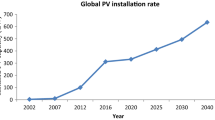Abstract
Cooling towers are one of the biggest heat and mass transfer devices that are in widespread use. In this work, the cooling tower model has been fabricated and silica gel mesh (SGM) column is installed at the inlet of the cooling tower. Experiments have been performed for three different modes namely with 0, 1 and 2 silica gel mesh with the subcases of varying air velocity and inlet water temperature. Experimental results demonstrated that the addition of a desiccant column (SGM) at inlet improves the range and effectiveness of the cooling tower. At higher inlet temperature (80°C and 4.3 m/s air velocity) the range of 2 SGM cooling tower is 2°C greater than without SGM cooling tower. This study also analyzes the effect of SGM column on the cooling water flow rate of the condenser of the thermal power plant and it has been found that required mass flow rate of SGM cooling tower is less than the normal cooling tower at any operating conditions. The minimum value of cooling water flow rate (32.05 kg/s) is achieved when inlet water temperature and velocity are 50°C and 3 m/s, respectively. Further, the maximum reduction in cooling water flow rate is 18.22% using two SGM column at 4 m/s velocity and 50°C inlet temperature. Hence, this modification helps improve the cooling capacity and reduce the water consumption of the cooling tower.

























Similar content being viewed by others
Abbreviations
- w r :
-
Resultant uncertainty -
- m g :
-
Mass flow rate of gas kg/s
- m l :
-
Mass flow rate of liquid water in cooling tower kg/s
- T G2 :
-
Temperature of air at the exit of cooling tower °C
- T G1 :
-
Temperature of air at the inlet of cooling tower °C
- T L2 :
-
Temperature of water at the outlet of cooling tower °C
- T L1 :
-
Temperature of water at the inlet of cooling tower °C
- ∆T max :
-
Maximum possible temperature difference in shell and tube heat exchanger °C
- \( {Y}_2^{\prime } \) :
-
Humidity ratio of air at the exit of cooling tower kg/kg
- \( {Y}_1^{\prime } \) :
-
Humidity ratio of air at the inlet of cooling tower kg/kg
- Y sat :
-
Humidity ratio at the saturated condition kg/kg
- H 2 :
-
Enthalpy of air at the exit of cooling tower kJ/kg
- H 1 :
-
Enthalpy of air at the inlet of cooling tower kJ/kg
- H L1 :
-
Enthalpy of water at the inlet of cooling tower kJ/kg
- H L2 :
-
Enthalpy of water at the exit of cooling tower kJ/kg
- c wl :
-
Specific heat of liquid water kJ/kg K
- c pg :
-
Specific heat of the air kJ/kg K
- ∆H vap :
-
Enthalpy of vapourization kJ/kg
- k y :
-
Mass transfer coefficient kg/m2s
- a :
-
Perimeter of control volume dz m
- h c :
-
Convective heat transfer coefficient W/m2K
- \( {\dot{m}}_{cw} \) :
-
Mass flow rate of cooling water consumed in the condenser kg/s
- H tg :
-
Height of enthalpy gas transfer unit m
- N tg :
-
Number of enthalpy gas transfer unit –
- z:
-
Height of packing section m
- H sat :
-
Enthalpy of air at the saturated condition kJ/kg
- \( {\dot{m}}_s \) :
-
Mass flow rate of steam in the condenser kg/s
- A s :
-
Surface area of desiccant m2
References
Merkel F (1925) Evaporative cooling. Z Verein Deutsch Ingen (VDI) 70:123–128
Jaber, Webb (1989) Design of cooling tower by effectiveness NTU method. J Heat Transf 111(4):837–843
Halasz B (1998) A general mathematical model of evaporative cooling devices. Int J Therm Sci 37:245–255
Poppe M, Rögener H (1991) Berechnung von Ruckkuhlwerken. VDIWa rmeatlas Mi1–Mi15
Kloppers JC, Kroger DG (2005) Cooling Tower performance evaluation: Merkel, Poppe and e-NTU Methods of analysis. J Eng Gas Turbines Power 127:1–7
Sultan A (2004) Absorption/regeneration non-conventional system for water extraction. Renew Energy 29:1515–1535
Zurigat YH, Abu-Arabi MK, Abdul-Wahab SA (2004) Air dehumidification by triethylene glycol desiccant in a packed column. Energy Convers Manag 45:141–155
Nia FE, Paassen DV, Saidi MH (2006) Modelling and simulation of the desiccant wheel for air conditioning. Energy and Buildings 38:1230–1239
Gadala M, Saghafifer M (2016) Performance assessment and transient optimization of air pre-cooling in multi-stage solid desiccant air conditioning systems. Energy Convers Manag 119:187–202
Elgendy E, Mostafa A, Fatouh M (2015) Performance enhancement of a desiccant evaporative cooling system using direct/indirect evaporative cooler. Int J Refrig 51:77–87
Deziani M, Rahmani K, Raoudaki SJ, Kordloo M (2017) Feasibility study for reducing water evaporative loss in a power plant cooling tower by using air to air heat exchanger with auxiliary Fan. Desalination 406:119–124
Naik BK, Muthukumar P (2017) A novel approach for performance assessment of mechanical draft wet cooling towers. Appl Therm Eng 121:14–26
Pedraza OJG, Ibara JJP, Maya CR, Gonzalez SRG, Arista JAR (2018) Numerical study of the drift and evaporation of water droplets cooled down by a forced stream of air. Appl Therm Eng 142:292–302
Chaudhary GQ, Ali M, Seikh NA, Gilani SI, Khushnood S (2018) Integration of solar-assisted solid desiccant cooling system with an efficient evaporative cooling technique for separate load handling. Appl Therm Eng 140:696–706
Holman JP (1994) Experimental methods for engineers, eighth edn
Web 2: https://www.sorbentsystems.com/desiccants charts.html
Author information
Authors and Affiliations
Corresponding author
Ethics declarations
Conflict of interest
On behalf of all authors, the corresponding author states that there is no conflict of interest.
Additional information
Publisher’s note
Springer Nature remains neutral with regard to jurisdictional claims in published maps and institutional affiliations.
Rights and permissions
About this article
Cite this article
Mishra, B., Srivastava, A. & Yadav, L. Performance analysis of cooling tower using desiccant. Heat Mass Transfer 56, 1153–1169 (2020). https://doi.org/10.1007/s00231-019-02759-y
Received:
Accepted:
Published:
Issue Date:
DOI: https://doi.org/10.1007/s00231-019-02759-y




